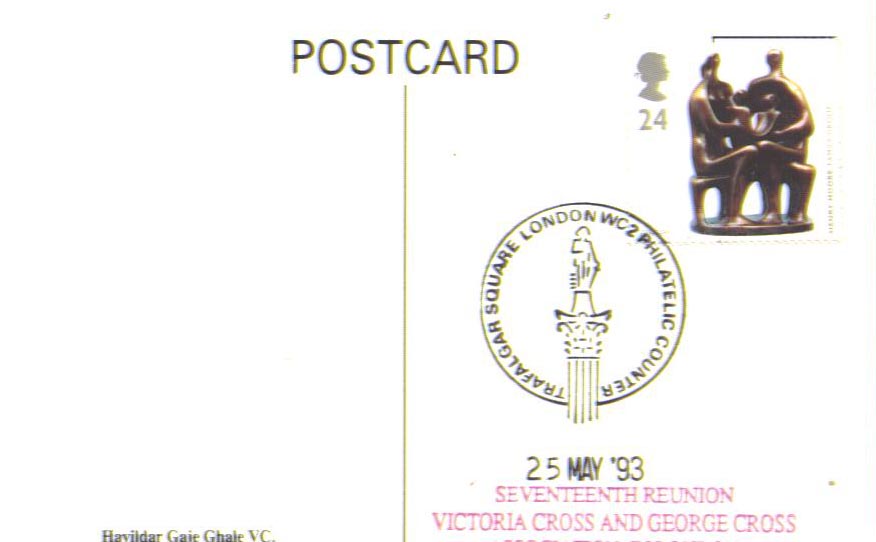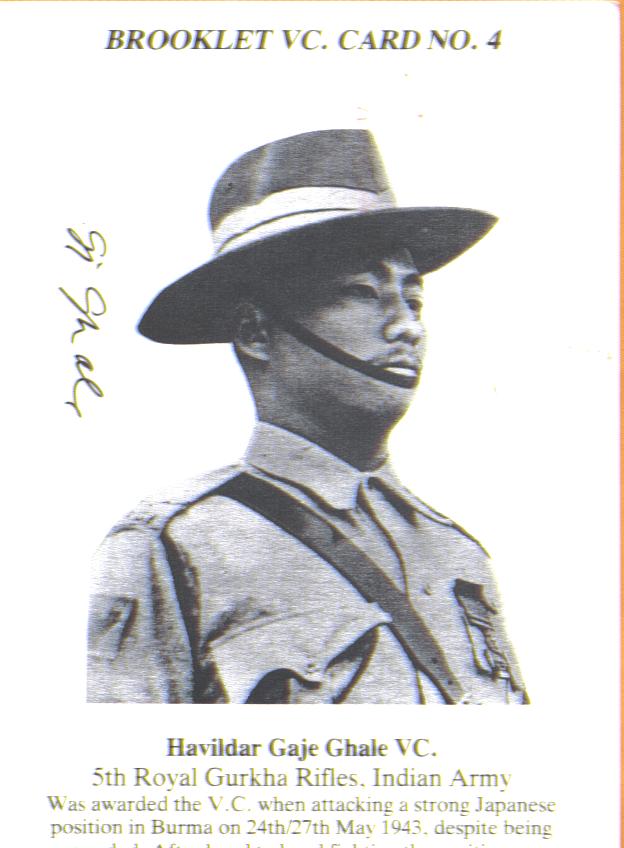

|
GHALE Gaje
Gaje Ghale
Born
1 August 1918
Barpak VDC, Gorkha District, Nepal
Died
28 March 2000 (aged 81)
He was 20 years old, and a Havildar in the 2nd Battalion of the 5th Royal Gurkha Rifles in the Indian Army during World War II when the following deed took place for which he was awarded the VC.
During the period 24/27 May 1943 in the Chin Hills, Burma (now Myanmar), Havildar Gaje Ghale was in charge of a platoon of young soldiers engaged in attacking a strong Japanese position. Wounded in the arm, chest and leg he nevertheless continued to lead assault after assault, encouraging his men by shouting the Gurkha's battle-cry. Spurred on by the irresistible will of their leader, the platoon stormed and captured the position which the havildar then held and consolidated under heavy fire, refusing to go to the Regimental Aid post until ordered to do so.
He later achieved the rank of Hon. Captain. born at Gorkha district of Nepal.
Captain Gaje Ghale, VC
Captain Gaje Ghale, who has died aged 81 in Delhi, was awarded a Victoria Cross, as a Havildar (sergeant) when leading a platoon of young soldiers of the 5th Royal Gurkha Rifles in Burma in May 1943.
Thursday 20 April 2000 01.06 BST
In May 1943 Gaje Ghale, who has died aged 81, was serving as a havildar (sergeant) with the 2nd battalion, 5th Royal Gurkha Rifles. It was during the 17th Indian Division's bitter and bloody struggle with the Japanese 33rd Division on the Tiddim Road in Burma, in the final phase of the Indian division's withdrawal through the Chin Hills.
The Japanese occupied a crucial position on the Basha East Hill, the approach to which was a narrow ridge little more than 15 ft wide. Two attempts to take the position faltered in the face of withering fire from Japanese machine-gun nests and artillery and mortars concealed in the jungle. On May 25, Gaje, now in command of his company's D platoon, was ordered to take the position.
Encouraging his riflemen and shouting the Gurkha's battle-cry "Ayo Gurkhali!" (the Gurkhas are upon you), Gaje attacked. Although badly wounded by a Japanese grenade, he led his men along the ridge and, apparently oblivious to the fire-power raining down, closed with the enemy in a bitter hand-to-hand fight.
It was an action which won him the Victoria Cross, and as the citation put it, Gaje "dominated the fight" with "his outstanding example, dauntless courage and superb leadership. Hurling grenades and covered in blood from his own wounds, he led assault after assault." The young Gurkhas, "spurred on by the irresistible will of their leader to win, stormed and carried the hill by a magnificent effort and inflicted heavy casualties on the Japanese." Having gained the position, Gaje held it, despite continued heavy fire, refusing to have his wounds dressed until ordered to do so by an officer.
Born in Barpak village in western Nepal, Gaje, a Gurung of the Ghale tribe, enlisted in the Indian army in 1934. Following training, he joined the 2nd battalion, 5th Royal Gurkha Rifles (Frontier Force), subsequently serving in Waziristan and in operations against that now-forgotten thorn in the side of the British Raj, the Fakir of Ipi. From 1939 to 1942, Gaje served as an instructor at the regimental depot in Abbotabad.
With the Japanese invasion of Burma, Gaje's battalion was despatched to Rangoon with the 48th Indian Infantry brigade, joining the 17th Indian Division at the Sittang Bridge in February, 1942. During the seemingly inexorable Japanese advance towards India, Gaje, always at the forefront of the fighting, distinguished himself on numerous occasions as the 17th Indian Division made its heroic withdrawal. Then came his VC-winning action.
In 1944 the Viceroy of India, Field Marshal Lord Wavell, presented Gaje Ghale with his VC at an investiture at the Red Fort in Delhi before a crowd of more than 5,000. In 1946, Gaje paid the first of many visits to London, taking part in the victory parade.
Following independence in 1947, Gaje, promoted Subadar Major, stayed with his battalion, which became part of the new Indian Army as the 5th Gorkha Rifles. He later saw service with the United Nations in the Congo in 1962-63. On his retirement from active service he was awarded the Star of Nepal at a special ceremony held in Kathmandu.
Granted the honorary rank of Captain, Gaje Ghale re tained close links with former regimental colleagues and was a frequent and very welcome guest in Britain, regularly attending reunions of the Victoria Cross and George Cross Association. With other Gurkha VCs, he attended the opening of the Gurkha Museum at Winchester in 1990, and was present at ceremonies marking the 50th anniversary of VJ Day in London in 1995. Those who were privileged to meet this remarkable man will long remember his striking presence and smiling countenance. Gaje Ghale, VC, was, indeed, one of "The Bravest of the Brave."
He was married with four sons and five daughters (one of whom predeceased him).
Gaje Ghale, VC, soldier, born August 1 1918; died March 28 2000.
Signed VC series card postmarked on the 50th anniversary of the award of his VC
Price: $40.00
Please contact us before ordering to confirm availability and shipping costs.
Buy now with your credit card
other ways to buy
|


